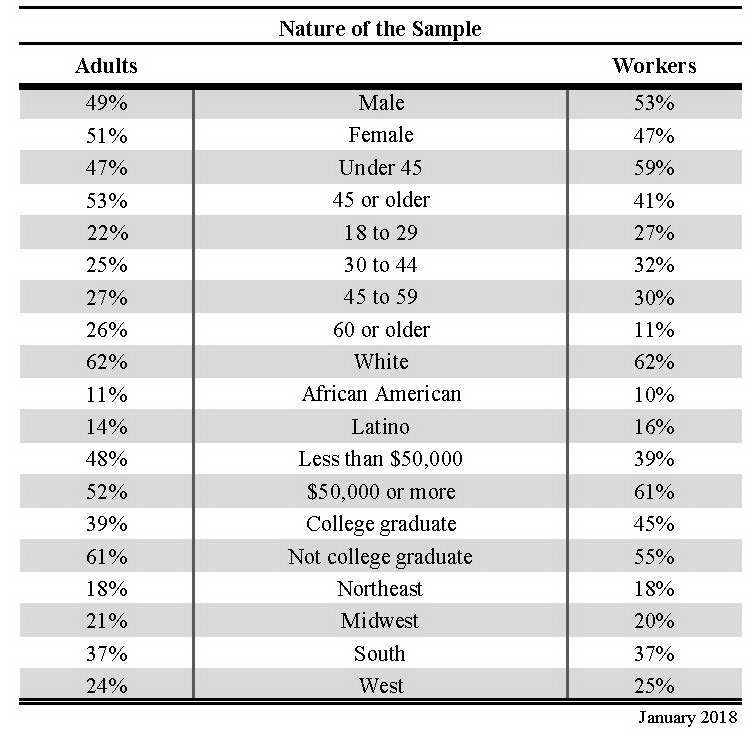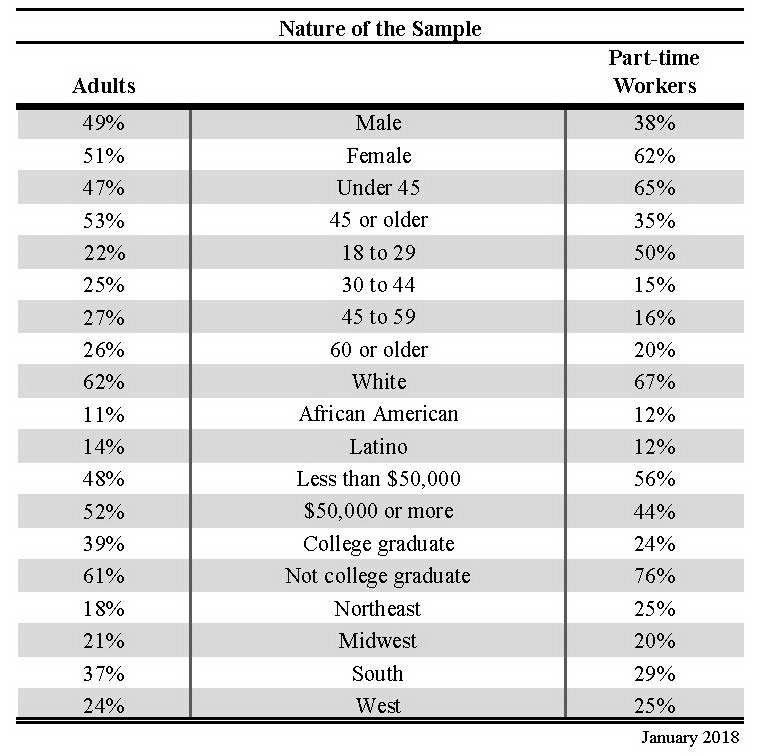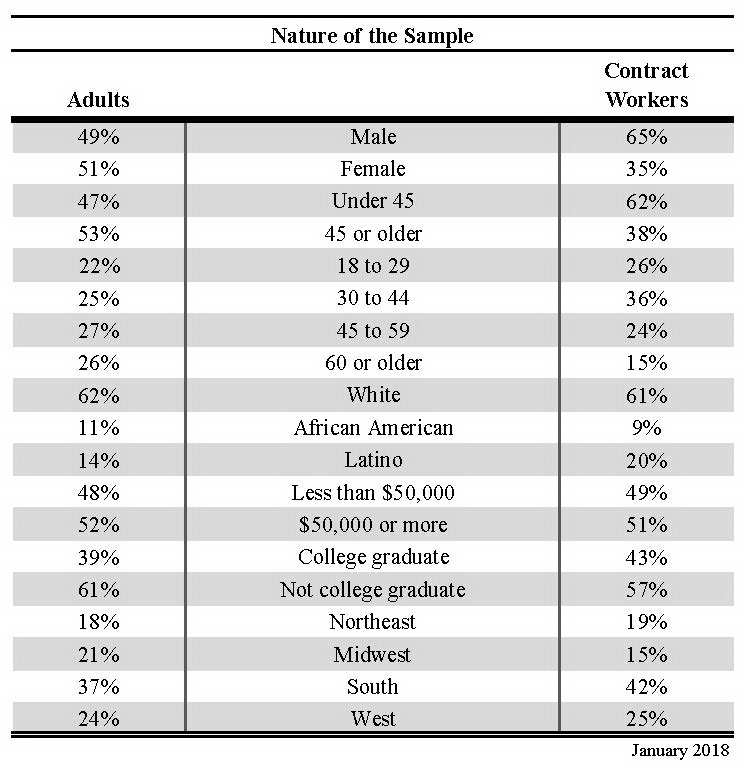January 23, 2018
American Worklife
NPR/Marist National Poll
Americans are carving out their own path in the labor force. Employment is not a “one size fits all” solution. A majority of U.S. workers who are not self-employed feel valued by their employer. And, if they are going to make an employment change, workers in the United States are going to do so on their own terms. Most workers do not think it is likely they will lose their job to automation, immigrants or foreign workers, or outsourcing.
While many full-time workers (70%), including those who are self-employed, do not do something else for pay, a notable 30% moonlight. When looking at part-time workers, three in four (75%) say they have had a full-time job at some point. One in four (25%) have only worked part time.
But, these workers are not necessarily working part-time because they cannot find full-time employment. In fact, two in three part-time workers (66%) prefer this type of schedule. 34%, though, are looking for full-time work.
A notable proportion of American workers (20%) are contract workers. That is, they are hired to work on a specific project or for a fixed period of time. Part-time workers (24%) are more likely than full-time workers (19%) to be contract workers.
More than three in ten American workers (32%) overall have changed jobs in the past two years. Part-time workers (41%), those who are working without benefits (39%), and those who have not received a raise in the past year (39%) are more likely than full-time workers (30%), those who have benefits (29%), and those who have received a raise (28%) to have switched jobs recently. Latinos (43%) and workers under the age of 45 years old (45%), including 59% of those under the age of 30, are more likely than white (29%) and African American workers
(29%) and those 45 or older (14%) to have taken a different employment path in the last two years.
Of those who have changed jobs, a majority (56%) are now earning more than they did in their previous job. 25% are earning less, and 19% are making about the same wages. There are some notable differences. Workers who have changed jobs and currently receive benefits in the recent past (63%) are more likely than those working without benefits (46%) to be earning more after their job change.
Workers in the United States who are not self-employed say they are valued by their employer. 90% of these workers think their employer values the work they do. This includes 53% who believe their employer greatly appreciates their contributions. Seven percent do not think their employer puts very much value in their work, and 3% do not think their boss appreciates their work at all.
A majority of American workers (56%) say they received a raise in the last year. Again, workers’ employment situations make a difference. Full-time workers (58%) are more likely than part-time workers (46%) to have received a raise. Workers who receive benefits (65%) are also more likely to have been given a pay increase than those without benefits (37%). And, workers who have the same monthly salary (60%) are more likely than those who have fluctuating pay (48%) to have received a raise.
Differences are also present based on age and gender. Workers younger than 45 years of age (59%) and those who are men (59%) are slightly more likely than older workers (51%) and women (52%) to have received a pay raise.
American workers, received an average pay increase of 4.5 percent. Workers under 30 years old (an average 6.4 percent raise) and those in the Northeast (an average 5.7 percent raise) have seen the largest pay increases.
Digging deeper into those figures, 19% of American workers who received a raise brought in between a two and four percent increase in their wages. 15% earned a raise of ten percent or more. 12% added between five and ten percent to their income while 4% received less than a two-percent increase. 44% of workers did not receive a raise in the past year.
Two in three workers (66%) say they earn the same amount from month to month. In contrast, 34% report their wages fluctuate throughout the year. In addition to their base earnings, 66% of workers have at least one of the following benefits: health insurance (59%), a retirement plan (53%), or a pension (27%).
Many workers (70%) think they are qualified to do their current job, although a notable proportion, 28%, believe they are over-qualified in their present position. Only 2% believe they are under-qualified. Part-time workers (43%) are nearly twice as likely as full-time workers (24%) to believe they are over qualified for the work they do. More than one in three Latino workers (35%) also believe they are not working up to their potential. This compares with 27% of African Americans and 24% of whites.
62% of workers have not looked for a job in the past year. Of the 38% who say they did, 11% thought they were over qualified for the job for which they applied. 22% felt they were qualified, and 5% said they were under qualified.
In addition, workers who are not self-employed (73%) think their employer offers at least a good amount of training to help them advance in their career. 27%, including 18% who report there are no opportunities at all, say they have fewer opportunities to get ahead. However, full-time workers (77%) are more likely than part-time workers (60%) to believe they have this opportunity.
A notable proportion of Americans perceive workplace sexual harassment to be a problem. Although 80% have not been a victim of such harassment, 19% say they have been the target. This is little changed from the 77% and 22%, respectively, who had these views in November. Of note, part-time workers (23%) are more likely to say they have been victimized than full-time workers (18%), and 32% of women say they have been sexually harassed compared with 7% of men. In addition, 22% of Americans say they have witnessed sexual harassment in the workplace.
On the question of relocation, a majority of workers (54%) think it would be difficult to relocate for a better job. Those 45 or older (61%), including 53% of those between the ages of 30 and 44, say it would be hard for them to relocate for a better job.
But, how many workers have had to relocate in the recent past? One in five (20%) say they have relocated at least once in the past five years to keep their job or take another one. 27% of workers under the age of 45 have moved for employment purposes. This compares with only 10% of older workers.
More than eight in ten American workers (84%) are not worried that they will lose their job in the next year although one-quarter of contract workers are concerned (25%). Most American workers do not feel their job is potentially threatened by outside factors. Most say it is not very likely or not likely at all that they will lose their job due to automation (94%), immigrants or foreign workers (94%), or to outsourcing (94%).
Who works in the United States?
The overall American workforce (63%) — defined as those who are employed full-time or part-time and those who are self-employed — is comprised mainly of full-time workers (80%). Two-thirds of workers in the United States (66%) have health care or retirement benefits, a majority (56%) received a raise in the last year, and 66% report their personal income does not fluctuate from month to month or seasonally. More than six in ten (61%) have a household income of at least $50,000 annually, and a majority of American workers (55%) do not have a college degree.

74% of the full-time workforce (including those who are self-employed) receive either health or retirement benefits, but a notable 26% work without them. A majority of full-time workers (58%) received a salary increase in the last year, and two-thirds (66%) say their monthly salary remains the same from month to month. About two-thirds of the full-time workforce (65%) earn $50,000 or more annually. Full-time workers evenly divide between those with a college degree (50%) and those without (50%).

The part-time workforce is in stark contrast with the full-time labor force. Nearly two-thirds of part-time workers (65%) labor without benefits, and a majority of these workers (54%) have not received a raise in the last year. Though, 64% report their monthly salary remains the same from month to month. A majority of part-time workers (56%) earn less than $50,000 a year, and most (76%) do not have a college degree.

Contract Workers are three times more likely to work full-time (76%) than to work part-time (24%). However, 40% of contract workers with a full-time job say they do something else for pay. They are equally as likely to have received a raise in the last year (50%) than to have not (50%) and are about as likely to earn a consistent monthly salary (51%) than to receive one that fluctuates (49%).

Complete January 23, 2018 NPR/Marist Poll Release of the United States
Complete January 23, 2018 NPR/Marist Poll of the United States (Tables of Adults and Registered Voters)
Marist Poll Methodology
Nature of the Sample

